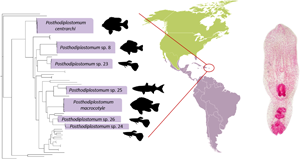Article contents
First integrative study of the diversity and specificity of metacercariae of Posthodiplostomum Dubois, 1936 from native and introduced fishes in the Caribbean
Published online by Cambridge University Press: 24 August 2022
Abstract

Metacercariae of the genus Posthodiplostomum are often recorded in freshwater fish hosts. While the diversity and taxonomy of this genus are receiving increasing attention in molecular phylogenetic studies, available data remain geographically biased. Most molecular studies of Posthodiplostomum and morphologically similar (neascus) worms originate in North America and Europe and Asia (more than 60% of DNA sequences are from USA and Canada), with few data currently available from the Neotropics, where high host diversity suggests high and under-sampled parasite diversity. In this study, we report molecular and morphological data from metacercariae of Posthodiplostomum in fish in Puerto Rico, where only a single species has been previously reported. Partial sequences of cytochrome c oxidase subunit 1 from metacercariae from Dajaus monticola (native to Puerto Rico) and the introduced fishes Poecilia reticulata, Parachromis managuensis, Lepomis macrochirus and Micropterus salmoides revealed 7 genetically distinct species-level lineages, of which 4 were novel. We report novel molecular life-cycle linkages in Posthodiplostomum macrocotyle (metacercariae in muscle of the cichlid Pa. managuensis), a species previously known only from adults in birds from South America; and in Posthodiplostomum sp. 23 (metacercariae in poeciliids), which has recently been found in Ardea herodias in Georgia, USA. We also report the first molecular data from Posthodiplostomum sp. 8 in M. salmoides in the Caribbean. Metacercariae of most species were morphologically distinguished and all displayed narrow specificity for fish hosts, with no indication of parasite sharing among introduced and native fishes.
Keywords
- Type
- Research Article
- Information
- Copyright
- Copyright © The Author(s), 2022. Published by Cambridge University Press
References
- 1
- Cited by





